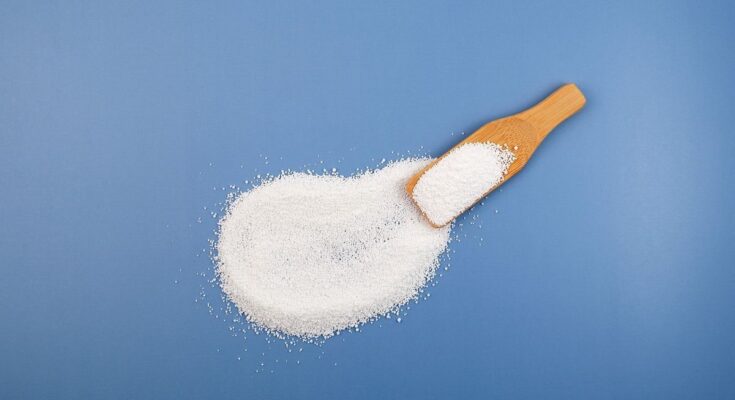What does food additive code E535 correspond to? What is its role and is it harmful to health? The answers from Anthony Fardet, researcher in preventive and sustainable nutrition and Claudine Plumail, dietician and nutritionist.
What is E535 (sodium ferrocyanide) and what is it used for?
The food additive E535 is also known as sodium ferrocyanide or sodium yellow prussiate. It appears as a white to pale yellow powder, but because it is used in small quantities in food products, its presence is generally not noticeable to consumers. These crystals are soluble in water, which explains why it is mainly used for its synthetic anti-caking agent properties. It therefore serves to limit the agglutination of particles in the form of lumps in a powder product, which contributes to its good fluidity. When sodium ferrocyanide is combined with iron, it becomes a dark blue pigment called Prussian Blue, which is the first modern artificial coloring.
In what foods is it found?
“Sodium ferrocyanide is only permitted for use in table salt or salt substitutes” said Claudine Plumail.
How are food additives classified?
Food additives are classified into 9 categories depending on their role:
- Food colorings, which can be of natural or synthetic origin;
- Preservatives to extend their shelf life;
- Antioxidants to prevent the oxidation of fats in foods;
- Sweeteners to give a sweet flavor to foods without adding sugar;
- Emulsifiers to stabilize mixtures of ingredients;
- Texturing agents (thickeners, gelling agents, stabilizers and bulking agents);
- Flavorings and flavor enhancers;
- Acidifiers to regulate acidity;
- Leavening agents added to baked goods to help dough rise.
Toxicity and risks: is this additive dangerous for health?
Sodium ferrocyanide is approved for use in the European Union and is considered safe when used in accordance with good manufacturing practices and permitted use levels. “Since its absorption is low for humans, since it is only present in table salt, there is no risk of accumulation and therefore no genotoxicity.” reassures Claudine Plumail. A grouped acceptable daily intake (ADI) was set at 0.03 mg/kg of body weight per day in 2020 for the consumption of all ferrocyanides (E535-538). Since 2020, however, The National Authority for Food, Environmental and Occupational Health Safety (ANSES) is interested in this additive and suspects it of being present in nanometric form in certain products.
“Note also that it is not because an additive alone poses little or no problem for health that its consumption is safe. Combined with other additives, it can become problematic: this is what we call the cocktail effect. Furthermore, we have no scientific perspective on the long-term health effects.” indicates Anthony Fardet, author of “Stop ultra-processed foods!” published by Thierry Souccar. For the researcher, the consumption of any so-called cosmetic additive – namely those which artificially modify the properties of color, texture and taste of food – should be limited as much as possible.
NO to diets, YES to WW!
E535: is this anti-caking agent halal or haram?
Sodium ferrocyanide (E535) is considered halal because it is synthesized from sodium and cyanide salts, and does not involve animal sources or processes prohibited in Islam.
What additives are prohibited?
Food additives that are not explicitly authorized in Europe are considered prohibited. The list is therefore non-exhaustive since currently, 320 additives are authorized in Europe, while – for example – some 450 are authorized in Canada. The list of additives authorized in Europe is available on the website of the Ministry of Agriculture and Food Sovereignty.





